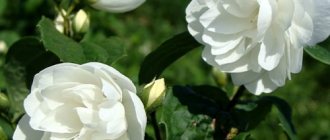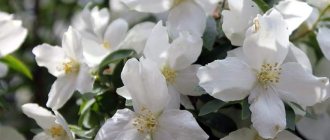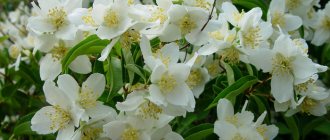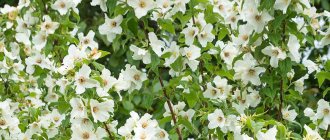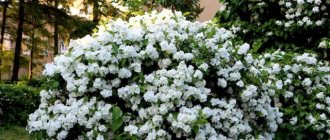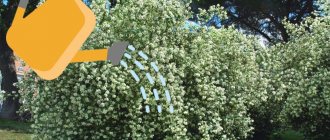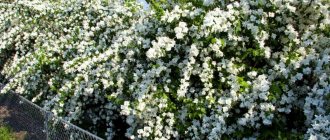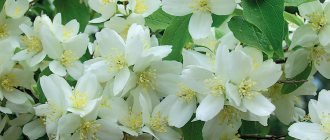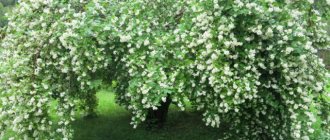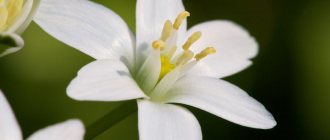Description of appearance
- The leaves are oval-shaped, located opposite each other on the shoots. The lower part of the leaf is usually not much pubescent.
- Inflorescences in the form of a brush can form both in the axils of the upper leaves and on the tops of the shoots.
- The flowers are simple in shape with 4 – 5 petals, large, up to 7 cm in diameter. The color of the flowers is white or with a cream tint.
Flowering mock orange became widespread in Russia back in the 16th-17th centuries. It was grown in the gardens of the king and boyars.
Some species are very winter-hardy and can withstand temperatures down to – 25C. For most varieties, already - 15C is the limit of possibilities, and they can freeze to snow cover. However, this does not harm the bush; it will grow back in the spring.
This is interesting: mock orange trunks are hollow inside. Previously, pipes and smoking pipes were made from them.
Plant characteristics
Garden jasmine is a deciduous shrub. It has erect shoots that are covered with thin brown or gray bark. Snow-white or cream-colored mock orange flowers are endowed with essential oils that give the plant a pleasant aroma. They have healing properties. Decoctions of flowers are useful; they normalize digestion and intestinal function, and have immunomodulatory properties.
Types and varieties of garden jasmine
There are many types of mock orange. There are more than 60 species in the wild. There are about 30 garden ones and quite a lot of derivatives from them. Each type of jasmine has its own unique aroma. Some representatives of this genus have no scent at all; some flowers have an aroma reminiscent of citrus fruits or strawberries.
The most commonly cultivated mock orange species in Russia include:
- small-leaved;
- coronary;
- fluffy.
Small-leaved mock orange
Relatively small shrub. Its height does not exceed 100 cm. The leaves are large and slightly curved. The flowers have a very pleasant aroma that resembles the smell of strawberries.
Coronet mock orange
Quite a big bush. Its height reaches 3 m. Its inflorescences are very large and have a pleasant, slightly sweet smell. The leaves have a very beautiful golden hue.
Fluffy mock orange
Usually planted in parks or dachas, large garden plots. The plant reaches a height of 4 m - this is the tallest variety of mock orange. Its peculiarity is long flowering, which lasts more than 4 weeks, as well as the absence of odor in the flowers.
The most famous varieties of garden jasmine
Many varieties and hybrid forms have been bred by foreign and domestic breeders, photo.
Mock orange crown
Chubushnik crown is a tall shrub, up to 3 meters high. The flowers are white, with a strong aroma. Retains the ability to flower up to 30 years of age. Frost-resistant, can withstand temperatures down to – 25C.
Minnesota Snowflake (snowflake)
Minnesota mock orange is frost-resistant. Large double flowers, with narrow petals, look like a wet snowflake. This appearance gave rise to the name of the variety.
Pearl
The “Pearl” variety is the fruit of Russian breeders. It is small in size. The flowers are large, up to 7.5 cm in diameter, with the scent of vanilla.
Blizzard
Terry mock orange, about 1 meter high. This is a highly decorative variety. Numerous flowers are formed at the ends of short branches, so they are arranged quite densely. It seems that the plant was caught in a snow storm.
Lemoine's mock orange is the result of the work of the French company after which it received its name. Popular varieties of this group.
Ermine Robe
Mock orange Ermine mantle is a low-growing shrub, no higher than 80 cm in height. On thin, hanging shoots there are miniature narrow leaves. The flowers are half double with narrow petals and exude the scent of strawberries. One of the longest and most abundantly flowering varieties.
Chubushnik Snowbel (Snow Beauty)
Mock orange Snowbel reaches a height of 3 meters, the shoots are erect with large, 7-centimeter leaves. Double flowers with a strong, pleasant aroma.
This is interesting: the snow beauty has an interesting property - it alternates the formation of double and regular flowers with a frequency of once every 2 years.
Use in landscape design
According to the description, mock orange snowbelle coronarius stands out especially strongly among all varieties. It is about 1.5 m wide and up to 2 m high. Double flowers have a diameter of 4 cm and look like balls, forming brushes of 7 pieces. Dazzling white color and a very delicate, unobtrusive aroma that cannot be confused with anything else. Flowering lasts for 3 weeks, capturing the middle of summer.
Philadelphus snowbelle is an extremely popular garden jasmine variety. It is good for use as a living fence, and can also adequately decorate any urban area, including boulevards, squares, and parks.
Park decoration
Mock orange snowbelle bears the title of king of garden shrubs. The status was obtained due to its unpretentiousness, the special beauty of flowering and durability. In the garden it is an incomparable spectacle for its romantic and landscape beauty.
This is interesting! In the very first days of summer, mock orange is associated with the image of a bride, in an airy veil of a veil of white delicate flowers. In a halo of pleasantly intoxicating aroma. The bushes have been growing for more than 10 years and delighting gardeners.
The perennial snowbell shrub looks very impressive against the backdrop of red brick buildings. Low-growing varieties around household ponds will perfectly decorate the area, or they will adequately occupy a strip under large trees in the lowest tier. Varieties of two or three meters in height form a magnificent hedge that blooms even after pruning. This kind of hedge is very popular; arches and secluded gazebos will sparkle differently with this decor.
Decoration against the background of a red building
Thus, mock orange is such a universal plant that it can perform any functions for an original decorative decoration. Garden jasmine at the moment of flowering will fill everyone with positive emotions, and its unique aroma will give a feeling of harmony.
Conditions for keeping mock orange
Garden jasmine is grown only in open ground; it requires a cold winter.
Requirements for the planting site, soil composition
The plant is famous for its unpretentiousness; caring for it is simple:
- The shrub prefers open, bright spaces, where it will grow for up to 25 - 30 years. It can grow in partial shade, but the number of buds and flowering duration will be lower.
- It is not picky about the composition of the soil, with the exception of places with poor drainage. Mock orange does not tolerate stagnant water or waterlogging of the soil.
Any cultivated soil with a universal composition is suitable for it: garden soil, peat, leaf humus, compost, in equal proportions. On loamy soils, additional drainage may be required: pebbles, expanded clay.
Fertilizing, watering
Regular watering is required, avoiding drooping of the leaves. Lack of moisture negatively affects flowering.
Feed the bushes twice a year:
- In early spring, fertilizers containing nitrogen are used: urea, slurry solution.
- At the end of flowering: superphosphate and potassium sulfate, in the dosage recommended by the manufacturer.
How to properly care
The plant requires some care.
Watering
When planting is complete, you need to water it abundantly. At a time, at least 30 liters. If the weather is rainy, then once every 7 days, and when there is drought, then every other day. Leaves serve as a visual indicator of the degree of soil moisture, which droop sharply if there is not enough moisture.
This is interesting! Loose soil is one of the necessary conditions. Immediately after quenching thirst, it needs to be loosened to a depth of 8 cm, then mulched. This will keep the soil airy and water retained. With diligent mulching, you can only build up layers in the future.
Top dressing
During the first time there is no urgent need for it. This can cause damage until the roots are fully developed. A year later, the mock orange is fed: a whole bucket of prepared nitrogen liquid for all the bushes. Even if the shoots have already been cut off, the “feeding” process continues.
Trimming
Annual shoots of jasmine serve to lay flower buds. As soon as flowering has passed, you should get rid of all branches with dried inflorescences so that all the plant’s forces can be directed to the development of fresh shoots. Before winter, get rid of excess branches to form a neat crown. And, of course, remove all damaged shoots. Thanks to pruning, it is possible to “revive” a fading old bush. With the beginning of early spring, it is enough to cut out as many branches as possible down to the roots, preserving only a few of the strongest ones. Prudently reducing them to about 30 cm.
The dull buds on these stumps will wake up, and young shoots will appear, which in the future will form such an attractive crown.
Pruning a jasmine bush
Mock orange blossom
Mock orange is grown in gardens for its beautiful flowers, which frame the plant like a bridal veil.
The start of flowering varies depending on the variety and lasts about 20 – 25 days.
In some cases, it stops forming buds, there are reasons for this:
- Age of the seedling. Bushes grown from cuttings bloom in 4–5 years. Seedlings from seeds will have to wait 7–8 years for flowering.
- Shadow. With a lack of lighting, the plant produces fewer buds.
- Severe freezing. This is a temporary phenomenon - after the growth of new shoots, flowering will resume.
- Excessive spring pruning.
Rules for cutting and forming a bush
To maintain a neat appearance and prevent thickening of the bush, the plant requires pruning. It comes in several types:
- Sanitary pruning. Weak, damaged branches, as well as shoots directed into the bush, must be removed. It can be carried out at any time of the year.
- Anti-aging pruning. Old branches older than 10-12 years are cut at the root. This procedure stimulates the formation of new shoots.
- Formative pruning of mock orange is carried out after flowering has ended. Faded shoots and green tops are removed to the level of lignification. Some varieties are shaped like a ball.
The first pruning of young plants is carried out after planting them in open ground. Only 2 - 3 branches are left, the rest are cut out.
Reproduction of mock orange
False jasmine reproduces easily and has good survival rate.
Cuttings
Propagation by cuttings is carried out in early summer.
Algorithm of actions:
- Green shoots are cut into pieces 8–10 cm long, the leaves are shortened by half.
- In partial shade, prepare a bed with the following soil composition: humus, turf soil, sand in equal proportions.
- Cuttings of cuttings are treated with a growth stimulator, then planted at a slight slope, to a depth of 1 cm.
- The soil is compacted, the cuttings are covered with glass or a plastic bottle. Sun protection should be provided.
- Plantings are ventilated daily. Rooting takes 2 - 3 weeks.
During the first winter, young plants will need shelter. In early spring, the first pruning is carried out at a level of 10–15 cm.
Propagation by seeds
This method is used more often by breeders. The seeds are pre-stratified in a cool place for 1.5 - 2 months. Since the seeds are very small, they are mixed with sand and scattered over the surface of the soil.
Picking is carried out in the phase of 4 true leaves. Planting seedlings in open ground is done in the spring, protecting them from the bright sun.
Root growth
With this method, you should carefully separate some of the young shoots with roots and plant them in a permanent place.
Preparing for winter
In the fall, the root system requires insulation with a layer of humus, or you can use compost. To increase frost resistance, you should use the addition of potassium-phosphorus fertilizers. Coconut felt laid on the ground will serve as an excellent insulation. As snow appears, the plants are covered with it until they gain size. In severe frosts, some varieties lose branches that are located above the snowdrift. But it's not scary. Bushes of heat-loving mock orange can be covered entirely. In the spring, as soon as the sun warms up, they unload it.
Diseases and pests
Of the pests, false jasmine is most susceptible to damage by aphids and hawthorn butterfly caterpillars. The following drugs have proven themselves well as control measures: Actelik, Iskra, Intavir.
The leaves are affected by fungal diseases - spots. Good prevention is to remove fallen leaves and spray with fungicides.
Mock orange combines remarkable properties - high decorativeness and ease of maintenance. Therefore, he firmly settled in the hearts and plots of gardeners.
